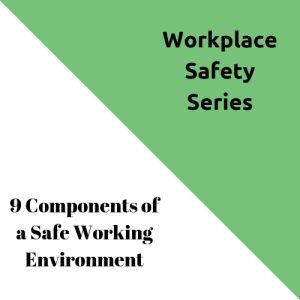9 Components of a Safe Working Environment
 A safe working environment is a condition or state, it is not necessarily an event like an incident of an accident. This means that the low number of incidents or accidents doesn’t mean that the workplace is particularly safe. What really counts is the process of safety because it is an integral part of everyday activities in the workplace. There are several activities which clear indicators of a safe working environment and this article lists 9 of them.
A safe working environment is a condition or state, it is not necessarily an event like an incident of an accident. This means that the low number of incidents or accidents doesn’t mean that the workplace is particularly safe. What really counts is the process of safety because it is an integral part of everyday activities in the workplace. There are several activities which clear indicators of a safe working environment and this article lists 9 of them.
1) Daily safety briefings. Every morning at the beginning of the work day or the shift, the leader holds an interactive safety briefing with his or her team. It lasts less than 10 minutes and has contributions from the team members.
Need Topics? Check out 12 Months of Toolbox Talks
2) Weekly inspections to identify unsafe conditions. Every staff member participates in turn and conducts a regular safety inspection where they look for hazards and unsafe conditions. This can occur weekly or twice a week.
Check Out: How to Setup an Internal Audit Schedule
3) Accident/incident investigation. Every accident or near accident is investigated with the sole objective of prevention in the future. The process of investigation is not a witch hunt to apportion blame
Need components of an Incident/Accident Program? Click here to see what I offer.
4) Constant improvement. During the daily safety briefings, the group members have an opportunity to recommend and discuss improvements to the workplace and the processes that are carried out within it
5) Reporting near misses. Every single near hit (this is an incident where no damage or injury occurs) is investigated and prevention measures are put in place so it will not happen again.
6) Positive reinforcement. Each day the leader goes into the workplace and gives positive reinforcement to those members of staff for working safely. This encouragement and enthusiasm for safety is a great motivator for safe working practices.
Check Out: Be Aware of the Negative Aspects of Positive Reinforcement
7) Blame. It is noticeable that all safe working environments do not use blame or punishment as tools for creating safe behavior. Instead, they use positive reinforcement, encouragement and recognition.
8) Practical on-the-job training. Group members are continually receiving on-the-job training from experts within the company and outside.
Check Out: Safety Training Is About Behavior Change
9) Effective leadership. Is no coincidence that all safe workplace environments have good leadership. This means that the leader is prepared to listen and has the skills to create followers. These leaders engender cooperation and most of all discretionary effort. They are the main reason why people are working safely. They are not invisible and spend between 30 and 50% of their time with their team members.
